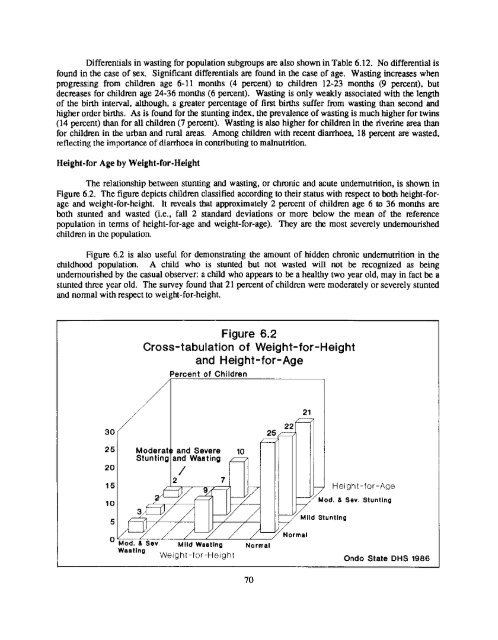Final Report (PDF, 2132K) - Measure DHS
Final Report (PDF, 2132K) - Measure DHS
Final Report (PDF, 2132K) - Measure DHS
You also want an ePaper? Increase the reach of your titles
YUMPU automatically turns print PDFs into web optimized ePapers that Google loves.
Differentials in wasting for population subgroups are also shown in Table 6.12. No differential isfound in the case of sex. Significant differentials are found in the case of age. Wasting increases whenprogressing from children age 6-11 months (4 percent) to children 12-23 months (9 percent), butdecreases for children age 24-36 months (6 percent). Wasting is only weakly associated with the lengthof the birth interval, although, a greater percentage of first births suffer from wasting than second andhigher order births. As is found for the stunting index, the prevalence of wasting is much higher for twins(14 percent) than for all children (7 percent). Wasting is also higher for children in the riverine area thanfor children in the urban and rural areas. Among children with recent diarrhoea, 18 percent are wasted,reflecting the importance of diarrhoea in contributing to malnutrition.Height-for Age by Weight-for-HeightThe relationship between stunting and wasting, or chronic and acute undemutrition, is shown inFigure 6.2. The figure depicts children classified according to their status with respect to both height-forageand weight-for-height. It reveals that approximately 2 percent of children age 6 to 36 months areboth stunted and wasted (i.e., fall 2 standard deviations or more below the mean of the referencepopulation in terms of height-for-age and weight-for-age). They are the most severely undernourishedchildren in the population.Figure 6.2 is also useful for demonstrating the amount of hidden chronic undemutrition in thechildhood population. A child who is stunted but not wasted will not be recognized as beingundemourished by the casual observer: a child who appears to be a healthy two year old, may in fact be astunted three year old. The survey found that 21 percent of children were moderately or severely stuntedand normal with respect to weight-for-height.Figure 6.2Cross-tabulation of Weight-for-Heightand Height-for-AgePercent of Children302520151050/ModeratStuntinMod. a Saywasting; and Severe 10 !an dWaeting ~I ~25~22~ ~ Height-for-AgeMild WastingWeight-for-Height217 Mod., ssv. s,un,,°,M,,Os,on,lngJ'Normal70/NormalOndo State <strong>DHS</strong> 1986








![Obtaining Informed Consent for HIV Testing [QRS4] - Measure DHS](https://img.yumpu.com/49850117/1/190x245/obtaining-informed-consent-for-hiv-testing-qrs4-measure-dhs.jpg?quality=85)







